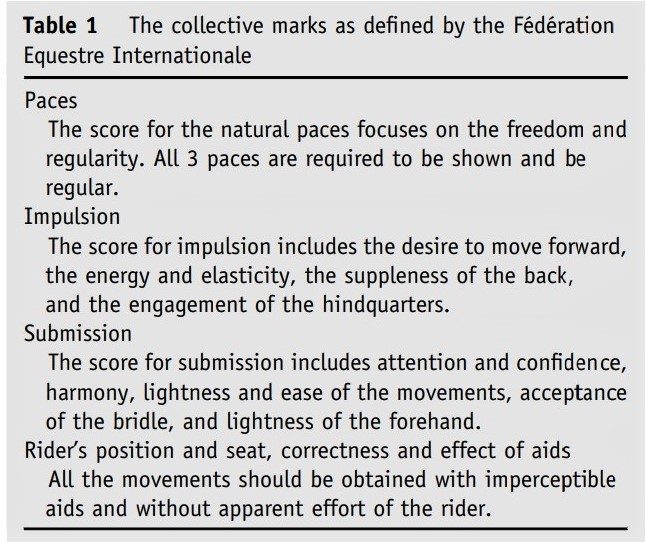
Correlations between olympic scores and equine welfare
This article analysed the practical integrations of the statements on equine welfare by the FEI in Olympic dressage competitions. This statement reckons that ‘‘the object of dressage is the development of the horse into a happy athlete through harmonious education’’. The results of this study reveal that, despite the relevance of the collective mark ‘submission’ to horses’ welfare, judges have considerable difficulty in scoring this domain. Additionally, athletes may focus too much on the collective mark ‘paces’ rather than submission.
The current dressage training scale is made up of six elements: rhythm; suppleness; contact and aids; impulsion; straightness; and collection. These elements are scored as the following four competition marks: paces; impulsion; submission; and the rider’s position and seat and correctness and effect of aids. The marks ‘paces and impulsion’ reflect the conformation and natural gaits of the horse whereas the marks ‘submission and rider position/ application of the aids’ reflect welfare of the horse during performances.
In this study, the correlations between these four marks were explored in scores from Olympic dressage competitions. Furthermore, the influence of the factors ‘judge position and nationality’ were examined.
Results showed that the four marks correlated with each other and all marks predicted the final percentage scores. It is stated though that the mark ‘submission’ made the least significant contribution. As approved in other sports, the judge position influences the scores significantly. No relations were find between nationality of judge and scores.
Expert opinion by Isabeau Deckers
Based on this article, we can state that there is more need for coherent performance-related evaluations of the physical and psychological welfare of our sport horses. Currently, equitation science is focussing on dressage because it is the training basis of all the Olympic equestrian disciplines. This study too is based on dressage marks in the Olympic athletes, but this point of view can be widened to all equestrian disciplines and up to every level. The FEI statement ‘‘the object of dressage is the development of the horse into a happy athlete through harmonious education’’ reflects positive evolutions in the management of equine welfare. Now it is just the question how we can integrate this in competitive scoring to motivate riders to emphasize common beneficial factors. A more consistent and clear scoring of the collective mark ‘submission’ in the dressage discipline might be a starting point to achieve this. (See collective marks for dressage test in figure 2.)
> From: Hawson et al., J. Vet. Behav. 5 (2010) 170-176. All rights reserved to Elsevier Inc.. Click here for the online summary.


